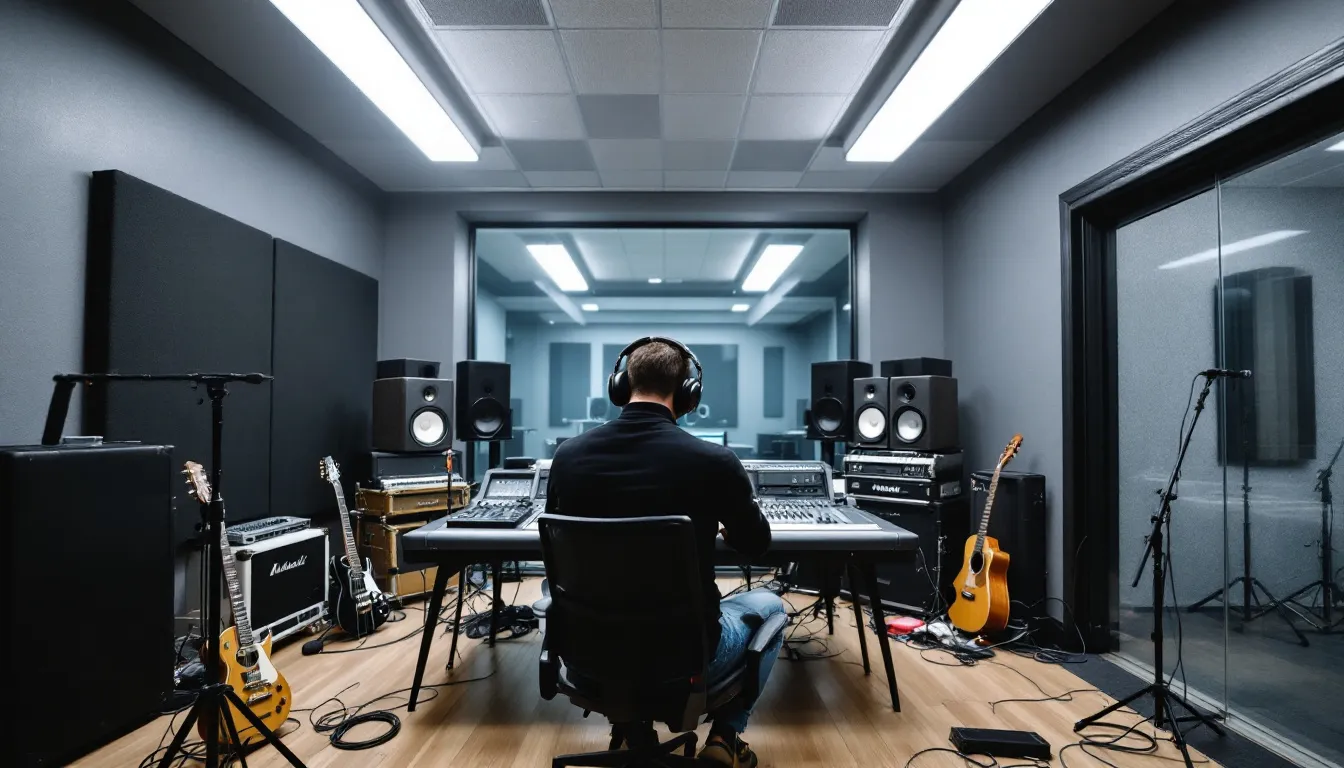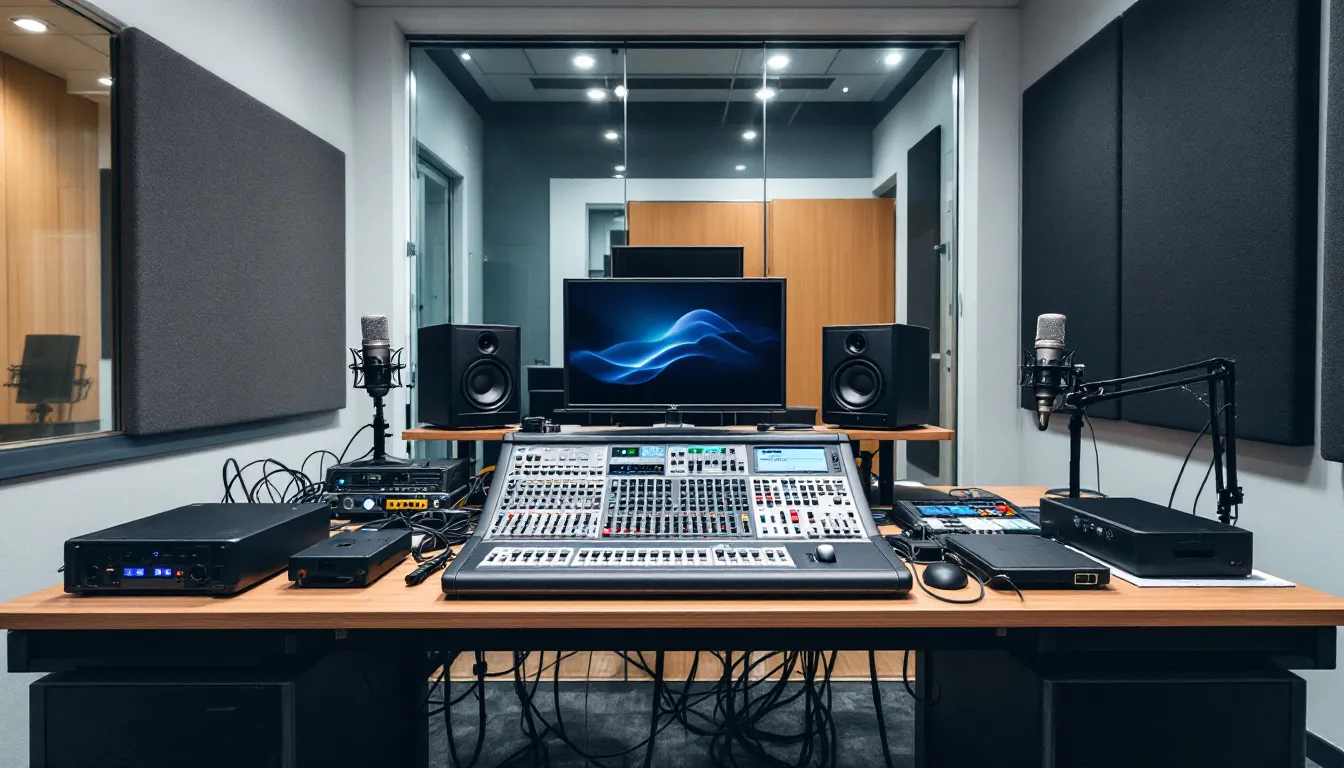In today’s music industry, over 60,000 songs are uploaded to streaming platforms every single day, making the path to a record deal more competitive than ever. Getting signed to a record label requires more than just talent—it demands strategic thinking, professional presentation, and deep industry knowledge that many aspiring musicians overlook.
Whether you’re dreaming of joining the ranks of artists signed to major labels like Universal Music Group or seeking the creative freedom that comes with independent artists on smaller labels, understanding how to navigate the complex world of record companies is essential for your music career success.
This comprehensive guide will walk you through the proven strategies that successful artists use to get signed, from developing your unique sound to maintaining momentum after securing your record deal. You’ll learn how to position yourself professionally, build the relationships that matter, and make informed decisions about the type of recording contract that aligns with your artistic vision and career goals.
Essential Steps to Get Signed to a Record Label
Getting signed to a record label requires a strategic approach that combines raw talent with professional business acumen. The music business has evolved dramatically, and today’s record labels look for artists who demonstrate both creative excellence and commercial viability before investing their resources.
The seven core steps to securing a record deal involve: defining your unique sound, creating professional-quality music, building a strong online presence, networking strategically within the industry, researching target labels thoroughly, submitting your music professionally, and obtaining proper representation. Each step builds upon the previous one, creating a foundation that positions you for success in today’s competitive landscape.

Success in securing a record label signing depends heavily on both preparation and timing. Many aspiring musicians focus solely on their creative output while neglecting the business side of their music career. However, in an era where record labels manage multiple artists and have limited resources, they prioritize artists who demonstrate professionalism, market awareness, and growth potential alongside their musical talents.
The modern music industry rewards artists who understand that getting signed is just the beginning of a long-term business relationship. Labels want to partner with musicians who can contribute to the marketing process, engage with fans authentically, and adapt to the rapidly changing digital landscape of streaming services and social media channels.
Define Your Unique Musical Identity
Developing a distinctive sound that sets you apart from millions of other artists represents the foundation of any successful record label pursuit. Your unique sound becomes your calling card in an oversaturated market where record labels receive thousands of submissions daily. Hone your craft in the studio to develop a unique sound distinct from others. This distinctiveness doesn’t mean being completely original—it means finding your authentic voice within existing genres while adding elements that make your music unmistakably yours.
Experimenting with different instruments, production techniques, and genre combinations can help you discover what makes your music special. Many successful artists blend influences from multiple genres to create something fresh. Electronic music producers might incorporate live instruments, hip hop artists might experiment with unconventional sampling, and indie rock bands might integrate electronic elements. The key is intentional experimentation that serves your artistic vision rather than following trends blindly.
Researching current market trends while maintaining authenticity requires a delicate balance. Study what’s working on streaming platforms like Apple Music and Spotify, analyze the sounds that emerging artists in your genre are creating, and pay attention to what industry professionals are discussing at relevant industry events. However, authentic artistry comes from internal inspiration rather than external pressure to conform to market demands.
Consider how artists like Justin Bieber evolved from YouTube covers to developing a signature pop sound, or how many hip hop artists create distinctive sonic signatures through unique production choices and vocal approaches. Each built their career on sounds that felt both contemporary and personally authentic, allowing them to stand out while remaining commercially viable.
Create Professional-Quality Music
The technical quality of your recordings can make or break your chances with record labels, regardless of how compelling your songs might be. Modern technology has democratized music production, allowing artists to create high quality music from home studios that rivals traditional recording facilities. Use the latest technology and software to create professional-grade music. However, this accessibility means that labels expect professional standards even from unsigned artists.
Investing in professional recording, mixing, and mastering services often pays dividends in the long run. While home recording equipment has improved dramatically, experienced engineers understand how to make tracks translate well across different playback systems and streaming platforms. They know how to achieve the sonic characteristics that A&R representatives expect when evaluating new music for potential signing. Invest in professional recording, mixing, and mastering services to ensure high production quality.

Creating a strong demo requires selecting your 3-5 best tracks that showcase your range as an artist. Your demo should demonstrate your songwriting abilities, vocal or instrumental skills, production sensibilities, and overall artistic vision. Many labels prefer shorter submissions that get to the point quickly rather than full albums from unknown artists.
Quality control extends beyond just the audio. Ensure your tracks meet the technical specifications required by major streaming services and digital stores. This includes proper metadata, appropriate levels that won’t cause distortion, and file formats that maintain audio integrity. Labels want to work with artists who understand these technical aspects of releasing music in the digital era.
Build a Strong Online Presence
A strong online presence has become non-negotiable for artists seeking record label attention. Labels now expect artists to demonstrate their ability to build and engage audiences independently before investing marketing resources. This digital foundation proves your commercial viability and reduces the risk for potential label partners.
Setting up professional profiles across Instagram, TikTok, Twitter/X, and YouTube requires consistent branding that reflects your artistic identity. Your visual aesthetic should complement your music and appeal to your target demographic. Many successful artists work with graphic designers to create cohesive visual identities that translate well across different social media channels and digital platforms.
Content strategy varies by platform but should always prioritize authentic engagement over follower counts. TikTok favors behind-the-scenes content and music previews that feel spontaneous, Instagram works well for polished photos and announcements, while Twitter/X excels for real-time interaction with fans and industry contacts. YouTube serves as an excellent platform for music videos, live performances, and longer-form content that showcases your personality.
Growing an organic fanbase to 10,000+ followers across platforms creates leverage when approaching major labels. This threshold demonstrates your ability to attract and retain audience attention, which translates to potential revenue streams that labels can amplify. However, engagement rates matter more than raw numbers—1,000 highly engaged fans often prove more valuable than 10,000 passive followers.
Creating a professional website with centralized access to your music serves as your digital headquarters. Implement SmartLink technology that directs visitors to their preferred streaming service, include an electronic press kit section for industry professionals, and maintain updated tour dates and news. Your website should function as a comprehensive resource for anyone wanting to learn about your music and career.
Network Within the Music Industry
Strategic networking within the music industry opens doors that talent alone cannot access. Building genuine relationships with A&R representatives, producers, managers, and other artists creates opportunities for collaboration, mentorship, and ultimately, record label introductions. Creating word-of-mouth buzz through personal networks can significantly benefit an artist’s career. However, effective networking requires offering value before seeking benefits.
Attending industry events like MIDEM, SXSW, and regional music conferences provides face-to-face interaction opportunities with industry professionals. These events attract decision-makers from record labels, publishing companies, booking agencies, and media outlets. Preparation is crucial—research attendees in advance, prepare elevator pitches for your music, and follow up professionally with new connections made during events.

Digital networking through platforms like LinkedIn and industry-specific Discord servers has become equally important as in-person connections. Many industry professionals maintain active online presences where they share insights, discover new talent, and conduct business. Engaging meaningfully with their content and contributing valuable perspectives to discussions can lead to meaningful professional relationships.
The key to successful networking lies in building genuine relationships rather than transactional interactions. Share other artists’ music that you genuinely enjoy, provide thoughtful feedback when asked, and offer assistance when possible. Industry professionals remember artists who contribute positively to the community rather than those who only reach out when they need something.
Connect with other artists in your genre who are at similar or slightly more advanced career stages. These peer relationships often prove more immediately beneficial than targeting high-level executives. Fellow artists understand the challenges you face and may provide introductions to their managers, labels, or booking agents when appropriate opportunities arise.
Research and Target Appropriate Labels
Thorough research into potential record labels dramatically improves your chances of finding the right partnership for your music career. Not all labels suit every artist, and understanding each label’s roster, resources, and reputation helps you make informed decisions about where to focus your submission efforts.
Start by identifying 5-10 labels that regularly work with artists in your genre and career stage. Study recent signings from major players like Atlantic Records, Sony Music, and Universal Music Group, but don’t overlook independent labels that might offer better terms for emerging artists. Each type of label offers different advantages and challenges that you should understand before pursuing them.
Understanding the fundamental differences between major labels, independent labels, and distribution deals helps you set appropriate expectations. Major labels provide extensive resources and global reach but typically offer lower royalty percentages and require significant creative input. Artists need to pay close attention to contract clauses, especially those concerning master recording ownership and revenue percentages. Independent labels often allow more creative control and higher royalty rates but may lack the resources for massive promotional campaigns.
Create a detailed spreadsheet tracking label contacts, submission guidelines, artist rosters, and recent signings. This organizational system prevents duplicate submissions and helps you personalize your approach to each label. Note specific A&R representatives who work with your genre, their contact preferences, and any recent interviews or social media posts that provide insight into what they’re seeking.
Research each label’s submission process carefully, as requirements vary significantly. Some prefer email submissions with specific subject line formats, others use platforms like SubmitHub for organized submission management, and many major labels only accept submissions through managers or established industry contacts. Following these guidelines exactly demonstrates professionalism and respect for their processes.
Submit Your Music Professionally
Professional music submission requires meticulous attention to detail and strategic timing that many aspiring artists underestimate. Your electronic press kit becomes your first impression with industry professionals, so every element must reflect the quality and professionalism you bring to your music career.
A comprehensive EPK includes a compelling artist bio that tells your story concisely, high-resolution photos suitable for print and digital use, streaming links to your best music, press coverage from credible sources, and notable performance history. Creating a professional-looking Electronic Press Kit (EPK) can help artists present themselves effectively to record labels. Each component should reinforce your artistic identity and commercial potential without overwhelming busy A&R representatives with unnecessary information.
Writing personalized cover letters for each submission demonstrates that you’ve researched the label and understand their roster. Reference specific artists they represent who complement your sound, mention recent label successes that align with your goals, and explain why your music fits their current direction. Generic submissions typically get deleted immediately, while thoughtful personalization shows respect for the recipient’s time.
Timing your submissions strategically can significantly impact response rates. Avoid major holiday periods when industry professionals are out of office, submit early in the week when people are more likely to check new music, and follow up appropriately after 4-6 weeks if you haven’t received a response. Persistence shows commitment, but excessive follow-up can damage your reputation.

Include links to your strongest tracks rather than attachments, which many email systems automatically filter out. Host your music on professional platforms that provide analytics, load quickly, and offer good audio quality. Many industry professionals listen to submissions on mobile devices, so ensure your music translates well across different playback systems.
Get Professional Representation
Hiring professional representation can dramatically accelerate your path to a record deal, but timing and selection matter tremendously. Music managers and entertainment lawyers bring industry relationships, business expertise, and negotiation skills that most artists lack, making them valuable allies in pursuing record label partnerships.
The benefits of hiring a music manager before approaching major labels include access to established industry relationships, professional guidance on career strategy, and credibility that opens doors for new artists. Experienced managers understand label preferences, submission protocols, and negotiation tactics that can mean the difference between getting signed and getting ignored.
Music managers typically earn 15-20% commission on all income they help generate, making them invested partners in your success rather than just service providers. They handle business communications, coordinate with other team members like lawyers and publicists, and develop long-term career strategies that extend beyond just securing a record deal.
Entertainment lawyers become essential when reviewing recording contracts and negotiating deal terms. Record label contracts involve complex legal language around intellectual property rights, royalty calculations, and future obligations that can impact your career for years. Legal representation ensures you understand what you’re signing and helps negotiate more favorable terms when possible.
Consider hiring representation when you’ve built sufficient momentum independently to warrant their attention. Managers and lawyers prefer working with artists who demonstrate growth potential, existing fanbase, and professional quality music. Having something to manage makes their job easier and increases the likelihood of successful label partnerships.
Understanding Different Types of Record Deals
The modern music industry offers several types of record deals, each with distinct advantages and limitations that impact your creative control, financial returns, and career trajectory. Understanding these options helps you make informed decisions when opportunities arise and negotiate from a position of knowledge rather than desperation.
Traditional record deals with major labels typically offer the most resources for marketing, distribution, and promotion but come with lower royalty rates ranging from 10-15% of net receipts. These deals often include multi-album commitments, extensive creative input from label executives, and significant investment in production and marketing that artists must recoup before receiving additional payments.
360 deals represent a more comprehensive partnership where labels participate in revenue from touring, merchandise, brand partnerships, and other income streams beyond just recorded music. While this gives labels more control over your overall career, it can provide additional support for developing these revenue sources and creating more sustainable artist careers.
Independent label deals often offer higher royalty rates between 50-70% while providing more creative freedom and closer working relationships with label staff. However, independent labels typically have smaller marketing budgets, limited radio promotion capabilities, and less influence with major streaming platforms and digital stores.
Distribution deals allow artists to retain ownership of their master recordings while accessing global distribution networks that place music on major streaming services and in physical retail locations. These arrangements typically involve lower upfront investment but give artists more control over their music and higher potential returns.
Pros and Cons of Each Deal Type
Comparing different deal structures requires understanding both immediate benefits and long-term implications for your music career. Financial considerations include not just royalty rates but also advance amounts, marketing commitments, and recoupment terms that determine when you’ll see ongoing income from your music. Shorter and more flexible contracts are increasingly being offered by labels to artists.
Major label deals provide access to radio promotion, playlist placement opportunities, and marketing budgets that independent artists rarely achieve on their own. However, they often require giving up ownership of master recordings and accepting lower royalty percentages that can limit long-term wealth building, as demonstrated by artists like Taylor Swift who later fought to regain control of their catalog. Artists should negotiate terms that allow them to retain ownership of their master recordings and publishing rights.
Creative control varies significantly between deal types, with major labels typically exercising more influence over song selection, production choices, and release timing. Independent labels and distribution deals usually allow more artistic freedom but require artists to take more responsibility for creative decisions and their commercial consequences.

Consider how streaming platforms like Spotify and Apple Music have changed deal economics. Physical album sales have declined dramatically, making streaming revenue, sync licensing opportunities, and live performance income increasingly important for artist sustainability. Advances are upfront payments given to artists to cover living and recording expenses, which must be recouped from future earnings. Modern deals must account for these shifts in how people consume and pay for music.
The rise of social media has also empowered artists to build direct relationships with fans, reducing dependence on traditional label marketing. Artists with strong online presence often have more negotiating leverage and may choose deals that preserve their ability to communicate directly with their audience.
Realistic Expectations vs. Industry Reality
Understanding the statistical reality of record label signings helps set appropriate expectations while maintaining motivation to pursue your music career goals. Less than 1% of submitted demos result in major label signings, making it one of the most competitive selection processes in any industry.
Most new artists who do get signed receive minimal advances and must continue self-promoting initially while labels evaluate their market response. The traditional model of labels fully funding unknown artists has largely disappeared, replaced by partnerships where artists demonstrate commercial viability before receiving significant investment. Artists should understand the recoupment process before signing a record deal.
Streaming has fundamentally changed how labels discover and evaluate talent. Modern A&R representatives look for artists with proven online traction, growing social media followings, and streaming numbers that indicate organic fan development. Labels want to amplify existing momentum rather than create it from scratch.
Alternative paths to success include building sustainable independent careers through direct fan support, sync licensing for television and film, and strategic partnerships that don’t require traditional record deals. Many artists generate substantial income through streaming revenue, live performances, merchandise sales, and sponsorship deals while maintaining full control over their music and career decisions.
The key is building a sustainable music career regardless of label interest. Focus on creating great music, developing genuine fan relationships, and building diverse income streams that don’t depend solely on record label support. This approach positions you for success whether or not you eventually sign a deal.
Maintaining Momentum After Getting Signed
Securing a record deal represents the beginning of a new phase in your music career rather than the culmination of your efforts. Successful artists understand that getting signed requires maintaining and accelerating the momentum that attracted label interest in the first place.
Continue growing your fanbase and creating quality content after signing, as labels expect artists to remain actively engaged in building their careers. Your signing gives you access to additional resources, but you remain responsible for the creative and promotional work that drives fan engagement and commercial success.
Working effectively with label teams requires understanding each department’s role and maintaining professional relationships with A&R representatives, marketing staff, radio promoters, and other team members. These professionals want to see you succeed, but they work with multiple artists and prioritize those who demonstrate commitment and professionalism.
Balancing label expectations with artistic vision can be challenging, especially when commercial considerations conflict with creative instincts. Successful artists find ways to honor their artistic integrity while meeting contractual obligations and commercial goals. Open communication with your label team helps navigate these challenges constructively.
Planning for long-term career sustainability extends beyond your first album cycle. Consider how each decision impacts your ability to build lasting fan relationships, develop your artistic skills, and create multiple income streams that support your music career over decades rather than just immediate commercial success.
The music industry rewards artists who think strategically about their careers while maintaining the creative passion that attracted fans in the first place. Stay focused on creating meaningful music, building genuine relationships with supporters, and developing the business skills necessary for long-term success in the evolving music landscape.
Getting signed to a record label requires combining artistic excellence with business acumen, professional presentation, and strategic relationship building. Success comes from understanding that the music business is exactly that—a business where talent must be packaged and presented in ways that reduce risk for potential partners.
Start by focusing on the fundamentals: develop your unique sound, create professional-quality recordings, and build an engaged online fanbase that demonstrates your commercial potential. These elements form the foundation for everything else in your career development.
Remember that record labels are looking for artists who can contribute to their own success rather than passive recipients of label investment. Approach the process with realistic expectations, professional preparation, and the understanding that building a sustainable music career takes time, persistence, and continuous learning.
Whether you eventually sign with a major label, independent label, or build a successful independent career, the skills and relationships you develop during this process will serve you throughout your music career. Focus on creating great music, building authentic fan relationships, and developing the business knowledge necessary to make informed decisions about your artistic future.
